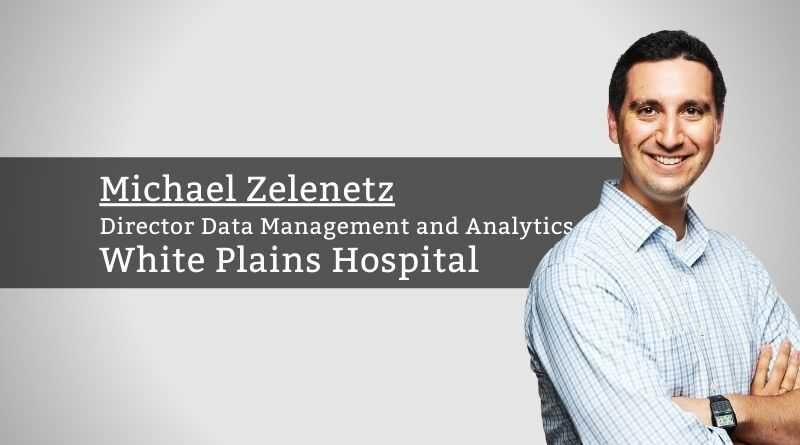The Peak of EMR Despair
By Michael Zelenetz, Director Data Management and Analytics, White Plains Hospital
We are at the peak of electronic medical record (EMR) despair. We were promised a utopian future where EMRs would improve communication, reduce the burden on handwritten notes and flowcharts, make administrative tasks more seamless, and hasten clinical research. While it seems our peers in other industries are charging into the information age, we in healthcare seem stuck firmly in its infancy. While the road is long, the destination is promising; and, like objects in the rear-view mirror, closer than they appear.
Twitter is awash with clinicians complaining about the additional overhead and stress caused by clunky EMRs. Some suggest that the added burden of EMRs contributes to provider burnout. Small physician groups or solo practitioners have suffered under the financial burden—many forced to close shop or join larger physician groups. As IT professionals, we are acutely aware of the difficulty of building custom applications on top of EMRs or integrating with other systems. As a result, EMR vendors have been forced to build integration and interoperability but aren’t going down without a fight.
Is the benefit worth the cost?
Are we seeing the benefits we were promised?
The answer: yes… almost.
We are tired from climbing to the peak, but as we summit the rise of EMR despair, we have an easier journey ahead of us. This utopian future is not inevitable. It will take a concerted effort on the part of providers, developers, EMRs vendors, regulators, and the broader HIT community to move the industry forward. At the core of this revolution are API-based integration and open standards such as FHIR that will enable secure, seamless integration between applications and building-block-like microservices. Advances in machine learning, artificial intelligence, and information retrieval will help reduce the burden on the end-user to sort through thousands of irrelevant data points, highlighting the most relevant information and aiding in diagnosis, communication, and disease management. Sensors, wearables, and IoT devices will further reduce the burden on clinicians to document and interact with the EMR directly.
As artificial intelligence/machine learning becomes more ubiquitous and easier to deploy in production, these tools will become increasingly important in information retrieval and reducing the clerical burden on clinicians.
The EMR is the glue that binds various systems in a healthcare system. As such, the EMR should act more like a platform than a stand-alone product. At the heart of any platform is a set of APIs and integrations. FHIR is a promising start and essential to achieving the ultimate vision. Future development on FHIR, such as bulk patient reads, will be critical to executing this vision. The EMR should be the central touchpoint for a provider and abstract away the various services and components working behind the scenes.
As artificial intelligence/machine learning becomes more ubiquitous and easier to deploy in production, these tools will become increasingly important in information retrieval and reducing the clerical burden on clinicians.
Currently, we rely on hard-coded alerts such as critical lab values or we expect clinicians to review results manually. Manual review of results does not scale, especially as the number of inputs and the frequency of data increases. For example, to efficiently manage a large remote patient monitoring practice that may enroll thousands of patients, manual human review of the data would be inadequate. Imagine streaming data from a wearable or implanted device and reviewing heart rate, respiration, EKG, pulse oximetry, fluid status, and steps manually. To efficiently implement such a program, one would need to use machine learning to alert where a clinician may need to intervene. This series of machine learning models would need to remove anomalies (we don’t want alerts every time a patient walks up the stairs), and potentially integrate with the EMR or other clinical systems to learn the clinical context.
Artificial intelligence and machine learning will also help summarize a patient’s past medical history and current clinical conditions and should help extract the findings from the totality of their medical record that are relevant to a given clinician. Improvement in semantic search will further reduce the burden on the clinician, allowing them to quickly find results or notes that are relevant to their query.
The proliferation of sensors, wearables, digital assistants, and IoT devices will further reduce documentation burden. A smart syringe may know what medication is being drawn up by a nurse, how much of that medication, and which patient is getting the medication. Nurses will not have to document vital signs, medication administrations, and other events that can be gathered from alternative sources.
Digital assistants will be installed in exam rooms and listen to a doctor’s conversation with a patient and will be able to pre-populate notes. Not only will this reduce the documentation burden on the clinician, but it will also capture a complete record of the encounter, and allow the doctor to speak to the patient without worrying about taking notes, clicking boxes, or dealing with the EMR during the visit—we will start to bring humanity back to medicine using technology.
Hang in there! While we are currently at the peak of EMR despair, the future is bright. By focusing on building EMRs with clean, intuitive user interfaces that act as a platform for uniting other technologies, we can reinfuse humanity into medicine.



